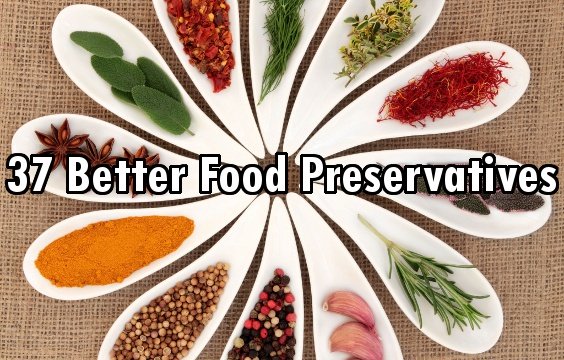37 Better Food Preservatives & AntiMicrobials than the Chemical Crap ‘they’ Put in Your Food

 The list of chemicals that food companies put in your food is extensive. From nitrates used to preserve meat that are linked to cancer and butylated hydroxyanisole (BHA) which has been shown to cause tumors in lab animals, food manufacturers look for cheap, chemical ways to store food so they can keep it on grocery store shelves for months or even years and ship it long distances. There are also sulfites, and food coloring that can contribute to depression, ADHD, and even Alzheimer’s disease.
The list of chemicals that food companies put in your food is extensive. From nitrates used to preserve meat that are linked to cancer and butylated hydroxyanisole (BHA) which has been shown to cause tumors in lab animals, food manufacturers look for cheap, chemical ways to store food so they can keep it on grocery store shelves for months or even years and ship it long distances. There are also sulfites, and food coloring that can contribute to depression, ADHD, and even Alzheimer’s disease.
The food manufacturing industry does all sorts of odd things to make more money with little care for your health, including cutting ‘extra virgin olive oil’ with food additives and oils that are definitely not from olives, to Greek yogurt manufacturers who produce tons of toxic waste every year that goes…who knows where?
Orange juice companies use ‘flavor packets’ full of chemicals and maraschino cherries are bleached with chemicals, then marinated with high fructose corn syrup and re-died to make them red. No one ever wanted these extra things in their ‘food.’ Just eating one of these food preservatives or additives is bad for your health.
“BHA and BHT have been used in food products, with some restrictions, since the late 1950s. TBHQ is a more recent addition to the list of antioxidants allowed in food, in Europe, it became an accepted antioxidant for food use in 2004. Their full names are: BHA:Butylated hydroxyanisole (E320) BHT: Butylated hydroxytoluene (E321) TBHQ: Tertiary-butyl hydroquinone (E319) There is nothing ‘natural’ about BHA, BHT, and TBHQ. They are synthetic compounds produced in laboratories. BHT was initially developed as an antioxidant for use with petroleum and rubber products.” (FoodCanMakeYou Ill)
The good news is that there are dozens of healthy, non-cancerous, natural foods and healthy bacteria that are antimicrobial and have great potential as food preservatives. For example, scientists searching for natural, toxin-free food preservatives discovered that washing produce in a solution of as little as 1% basil essential oil decreased Shigella contamination below levels at which it could be detected.
Of course, eating fresh and local is still the best, but here is a list of 37 better preservatives to look to instead of the chemical cocktails being used by PepsiCo, Cargill, Tyson, Nestle, Kraft, General Mills, and the other 100 top food manufacturers.
Potential Natural Food Preservatives |
||
| Plants with Natural Antimicrobial Activity | Antimicrobials From Microorganisms (Bacteria) | Antimicrobials from Animals |
| Basil Caraway Cardamom Cinnamon Clove Coriander Cumin Fennel Garlic Grape Green tea Marjoram Mint Mustard Nutmeg Onion Oregano Peppers Rosemary Sage Thyme |
Acidophilin Bulgaricin Colicins Helveticin Lactacin Natamycin Nisin Pediocin Plantaricin Reuterin |
Chitosan Defensins Lactoferrin Lactoperoxidase system Lysozyme Pleurocidin |
